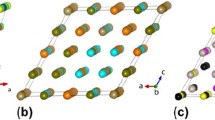Abstract
The list of physical properties which are important in the design of materials and which are routinely calculated from first principles within the local density approximation to density functional theory is continually growing. In this paper we discuss the application of multiple scattering theory to the calculation of the residual resistivity of disordered alloys. Progress has been made on two fronts. First, the coherent potential approximation for the resistivity, which sums to all orders a limited set of multiple scattering diagrams, has given resistivities in agreement with experiment for alloys where the site occupation is roughly random. Second, the linearized KKR was used to evaluate the Kubo formula for several large configurations of atoms and obtain the resistivity with all multiple scattering paths included. This method is not limited to random alloys, but can be applied to short range ordered and amorphous alloys provided the resistivity is high enough to limit the mean free path to a single unit cell.
Similar content being viewed by others
References
R. Kubo, J. Phys. Soc. Jpn. 12, 570 (1957).
W. H. Butler, J. S. Swihart, G. M. Stocks, D. M. Nicholson, and R. C. Ward, Phys. Rev. Lett. 57, 1181–84 (1986).
R. H. Brown, P. B. Allen, D. M. Nicholson, and W. H. Butler, Phys. Rev. Lett. 62, 661 (1989).
H. Yang, Thesis (1991) unpublished.
Chen, Phys. Rev. Lett.
D. D. Johnson, D. M. Nicholson, F. J. Pinski, B. L. Gyorffy, and G. M. Stocks, Phys. Rev. Lett. 56, 2088 (1986).
G. S. Cargill{iiiIII}, J. Appl. Phys. B 23, 315 (1976); J. P. Carini, S.R. Nagel, L. K. Varga, and T. Schmidt, Phys. Rev. B 27, 7589 (1983).
S. Aryainajud, Ph.D. thesis, Indiana University, Bloomington, Indiana, (1983) unpublished; N. E. Alekseevskii, A. V. Mitin, and N. M. Matveeva, Zh. Eksp. Teor. Fiz. 69, 2124 (1975) [Soy. Phy. JETP 42,1080 (1976)].
T. S. Lei, K. Vasudevan, and E. E. Stansbury, Mat. Res. Soc. Symp. Proc. Vol 39, 164 (1985).
W. H. Butler, Phys. Rev. B 31, 3260 (1985); L. M. Schwartz, Phys. Rev. B 24, 1091 (1981).
L. M. Roth, Phys. Rev. B 9, 2476 (1974); D. M. Nicholson and L. M. Schwartz, Phys. Rev. Lett. 49, 1050 (1982).
J. G. Kirkwood, E. K. Maun, B. J. Adler, J. Chem. Phys. 18, 1040 (1950).
J. H. Mooij, Phys. Status Solidi A 17, 521 (1973).
C. C. Tsuei, Phys. Rev. Lett. 57, 1943 (1986).
M. Jonson and S. M. Girvin, Phys. Rev. Lett. 43, 1447 (1979); S. M. Girvin and M. Jonson, Phys. Rev. Lett. 57, 1181 (1986).
P. Lamparter and S. Steeb, Proceedings of the 5th International Conference of Rapidly Quenched Metals (1984).
H. Yang, Ph.D. thesis, Indiana University, Bloomington, Indiana, (1990) unpublished.
H. Thomas, Z. Physik, 129 (1951).
B. Chakravarti, E. A. StarkeJr., C. J. Sparks, and R. O. Williams, J. Phys. Chem. 35, 2017 (1974).
D. M. Nicholson, G. M. Stocks, F. J. Pinski, A. Gonis, B. L. Gyorffy, and D. D. Johnson, Bull. Am. Phys. Soc. 33, 529 (1988); D. M. Nicholson, unpublished.
B. Schonfeld, L. Reinhard, G. Kostorz, W. Buhrer, Phys. Stat. Sol. (b) 148, 457 (1988).
Acknowledgement
Research sponsored by the U.S. Department of Energy, Assistant Secretary for Conservation and Renewable Energy, Office of Industrial Technologies, Advanced Industrial Concepts Division, Advanced Industrial Concepts (AIC) Materials Program, and Division of Materials Science, Office of Basic Energy Sciences under contract DE-AC05-84OR21400 with Martin Marietta Energy Systems, Inc., and by the National Science Foundation, Grant No. DMR 81-17013. The work of P. B. Allen was supported by the Division of Materials Science, U.S. Department of Energy, under contract DE-AC02-76CH0016. The research was assisted by the participation of the authors in the alloy workshops sponsored by IBM, held at the University of Kentucky Computer Center. The large matrix calculations were done at the Cornell National Supercomputer Facility
Author information
Authors and Affiliations
Rights and permissions
About this article
Cite this article
Nicholson, D.M., Brown, R.H., Butler, W.H. et al. First Principles Calculation of Residual Resistivity. MRS Online Proceedings Library 253, 269–276 (1991). https://doi.org/10.1557/PROC-253-269
Published:
Issue Date:
DOI: https://doi.org/10.1557/PROC-253-269




